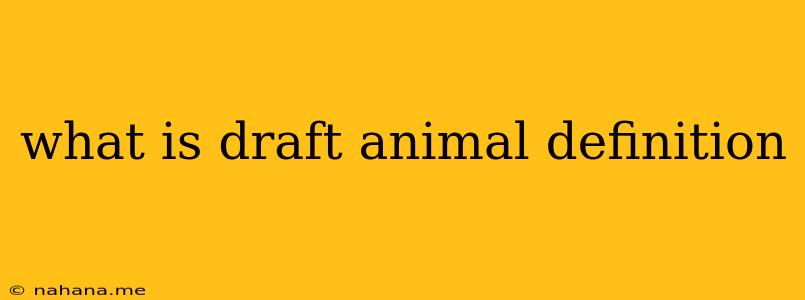Definition:
A draft animal is an animal that is specifically bred and trained to perform heavy labor, particularly pulling loads. These animals are typically strong and robust, with a powerful build and a temperament suited for working alongside humans.
Characteristics of Draft Animals:
- Strength and Endurance: Draft animals possess remarkable strength and the ability to sustain long periods of physical exertion.
- Size and Build: They are typically large and sturdy, with broad chests, muscular legs, and strong hooves.
- Temperament: Draft animals are generally docile and trainable, allowing for safe and effective work.
- Adaptability: They are often adaptable to various environments and climates.
Examples of Draft Animals:
- Horses: Throughout history, horses have been the most widely used draft animals, particularly for plowing, hauling, and transportation.
- Oxen: Oxen, domesticated cattle, have also been employed for centuries, especially in agriculture.
- Mules: Mules, a hybrid of a donkey and a mare, are known for their strength and hardiness.
- Donkeys: Donkeys, while smaller than horses, are still used for carrying loads and pulling carts in certain regions.
- Camels: Camels are adapted to arid environments and used for transporting goods and people in desert regions.
- Yaks: Yaks, native to the Himalayas, are used for plowing and hauling in mountainous areas.
Uses of Draft Animals:
Draft animals have played a crucial role in human history and continue to be utilized in various ways:
- Agriculture: Plowing fields, hauling hay, and transporting crops.
- Transportation: Pulling carts, wagons, and sleds for goods and people.
- Logging: Moving logs in forestry operations.
- Construction: Hauling heavy materials and equipment.
- Recreation: Pulling carriages and sleighs for leisure activities.
Importance of Draft Animals:
- Sustainable Agriculture: Draft animals provide an eco-friendly and sustainable alternative to mechanized farming.
- Economic Development: In many regions, draft animals are essential for livelihoods and economic activity.
- Cultural Significance: Draft animals are deeply embedded in the cultural heritage of many societies.
- Conservation: Some draft animal breeds are facing declining populations and require conservation efforts.
Conclusion:
Draft animals have been invaluable companions to humans for centuries, contributing significantly to our history, culture, and economy. Their strength, endurance, and adaptability continue to make them essential for various purposes in both modern and traditional societies.
